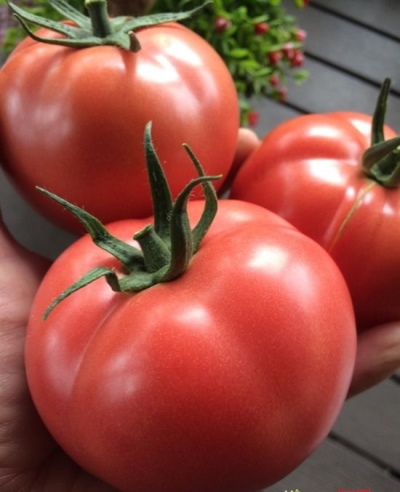
- Authors: Ortega Luis
- Year of approval: 2017
- Name synonyms: Mamston
- Category: hybrid
- Growth type: indeterminate
- Appointment: fresh consumption
- Ripening period: mid-season
- Ripening time, days: 58-60 days from disembarkation of seedlings
- Growing conditions: for film greenhouses
- Marketability: high
The Mumston variety belongs to the new generation of premium hybrids. The variety produces a high yield that is easy to transport and can be stored for several months. Differs in exceptional resistance to adverse conditions and diseases. Suitable for growing in a garden area and for industrial cultivation. Consumed fresh.
Breeding history
Obtained on the basis of the Dutch company "Syngenta". The author is Ortega Lewis. Included in the State Register in 2017
Description of the variety
Bushes are tall, reaching 200 cm in height, compact, sturdy stems, short internodes, strongly leafy bush, medium-sized leaves, green. Indeterminate type of growth. Forms 12-18 inflorescences, 6-7 tomatoes can be tied on each, on the upper ones the number of fruits is reduced, on the first clusters they are larger. Suitable for plastic greenhouses and polycarbonate. Ideal for regions with short summers and unstable climates.
The main qualities of the fruit
Medium size, weighing 120-130 g, flat-round even shape, bright pink color, dense juicy pulp, smooth skin, not prone to cracking. Excellent presentation, good transportability, can be stored for up to 2 months.
Taste characteristics
Bright, sweet, tomato flavor.
Ripening and fruiting
Mid-season in terms of ripening, from the moment of planting the seedlings to the removal of tomatoes, it takes 58-60 days. Can be planted on an industrial scale for fruiting in spring and autumn.
Yield
High-yielding variety: up to 7 kg of tomatoes can be removed from one bush. Differs in a high ripening rate. After reddening, the fruits can be stored on the branches for a long time without losing their appearance and taste. This makes it possible to harvest in batches on farms.
The timing of planting seedlings and planting in the ground
In special greenhouses it bears fruit all year round. Seeds for seedlings are sown in 40-45 days of transferring the culture to the garden. On the 18-20th day, dive in a container of at least 600 ml. Seedlings are watered infrequently, about 1 time per week, calcium nitrate is added with each watering, it is alternated with monopotassium phosphate. Water is taken with an acidity of 5.5-5.8 pH. The seedling bed should be well warmed up.

Growing tomato seedlings is an extremely important process, because it largely depends on whether the gardener can harvest at all. All aspects must be taken into account, from seedbed preparation to planting in the ground.
Landing scheme
Seedlings are placed at a distance of at least 45 cm from each other, but it is better to increase the distance. Place no more than 3 plants per 1 sq. m. With a denser planting, the plants bring many small tomatoes.

Growing and care
The hybrid needs the easiest care.Form into 1-2 stems. It is recommended to thin out the lower part of the leaves to avoid excessive thickening. It is enough to leave about 15 leaves. 3 leaves are left between the brushes. Before harvesting for 14 days, the lower part of the bush is exposed. No more than 4 leaves are removed at a time. Fruit brushes must be tied up with soft braid to strong supports, as they break off easily. Shade from the direct bright sun, the greenhouse must be ventilated on hot days. Higher temperatures can cause the tomatoes to crack. Requires moderate feeding and hilling. It responds well to complex feedings, which alternate with organic ones.
Watered evenly with water not lower than 15-18 degrees, in the morning 2 hours after sunrise, no more than 2 liters per plant. You can organize drip irrigation. The soil must be loosened after watering. Mistakes in agricultural technology can affect the size of tomatoes, but their taste does not change.




A plant needs different micronutrients at each stage of growth. All fertilizers can be divided into two groups: mineral and organic. Folk remedies are often used: iodine, yeast, bird droppings, eggshells.
It is important to observe the rate and period of feeding. This also applies to folk remedies and organic fertilizers.
Disease and pest resistance
The culture is distinguished by a very high immunity. For the prevention of fungal diseases, you can use the "Quadris" or "Switch". It is better to carry out processing 2-3 hours before sunset in summer, in autumn during the daytime. The procedure is carried out 3 times with an interval of 10 days. They do not spray it from gray rot, but shed the soil and wash the shoots.


Resistant to adverse weather conditions
The variety is distinguished by high adaptation to extreme circumstances, perfectly sets and pours fruits in difficult weather conditions, tolerates lack of lighting, high temperatures.
Growing regions
Recommended for planting in greenhouses throughout Russia and Belarus.
Review overview
I really like the taste and excellent yield of the hybrid. They are used not only for making salads, but also for juices, lecho. Has a reputation for being unpretentious and easy to care for.Among the disadvantages, they say that seeds are very expensive on the market.

























































































